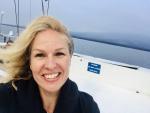
10 tips on how to do business with European tourism buyers
Building successful relationships with tourism suppliers is important for business. The business to business (B2B) tourism buyers’ market in Europe is crowded and competitive. It is made up of tour operators, online travel agencies (OTAs) and travel agents. It is a mature market with very experienced operators. To work well with these professionals, you need to understand how to do business with them.
Contents of this page
- Understand the business culture of your buyers
- Honesty and clarity are vital
- How to have productive meetings with European tour operators
- Create a unique selling point for your product
- Consider teaming up with DMCs or other local tour operators
- Market your trips and experiences online
- Market your trips and experiences online
- Set a fair price for your services
- Be upfront about infrastructure and service provision in your destination
- Join trade membership organisations
1. Understand the business culture of your buyers
Understanding how people do business is essential to developing successful business relationships. Every region in Europe does business a bit differently. This is called ‘business culture’. Business culture includes normal behaviours, the ethics and etiquette. It also refers to organisations’ values, beliefs and working methods. Europe is a diverse continent, but countries grouped in geographical regions share similarities in how they conduct business.
- Northern Europe: People in the United Kingdom (UK) and Ireland are native English speakers. People in Denmark, Finland, Iceland, Norway and Sweden (Scandinavia) have a good level of English. Businesspeople in these countries like getting facts and technical details. Punctuality is regarded as a sign of reliability and professionalism. It is appropriate to use titles (Mr, Mrs, Ms) until the client switches to using first names.
- Western Europe: Businesspeople in Austria, Belgium, France, Germany, Luxembourg and the Netherlands like formal business practices. They prefer documentation and formalities over personal business relationships. Punctuality is also important to this group. English is widely spoken in these countries. In the case of French businesspeople, if you can speak French to them, this can be very positive.
- Southern Europe: In Croatia, Cyprus, Macedonia, Greece, Italy, Malta, Portugal, Slovenia, Spain and Turkey, it is important to develop personal relationships when doing business. Contacting the right people and maintaining strong bonds with business partners is essential. Trustworthiness, loyalty and respect are key elements for doing business with partners in these countries.
- Eastern Europe: This group of countries (Bulgaria, Czech Republic, Hungary, Estonia, Latvia, Lithuania, Poland, Romania and Slovakia) is too large and diverse for generalisations. If you plan to do business with partners in any of these countries, do more research into the specific country, its language and business culture.
You can find out more about business culture, etiquette, developing international business relationships and individual European markets on Passport to Trade 2.0. There are some useful country guides that offer advice on culture, etiquette, customs and how to conduct business meetings. All the major European markets are there, including Germany, the United Kingdom, the Netherlands, France, Spain and Italy. Look at the Scandinavian markets too, including Sweden and Denmark, as well as the Eastern European market.
This website, Cultural Atlas, also provides profiles of numerous countries around the world, including several in Europe.
You can also consult source market tourism boards for the countries you target. These may have sections that cover common cultural behaviour, such as Deutschland.de. These could include conventional greetings, how to address people, the meaning and importance of gestures, negotiating styles and customs around giving and receiving gifts.
Figure 1: Doing business with European buyers
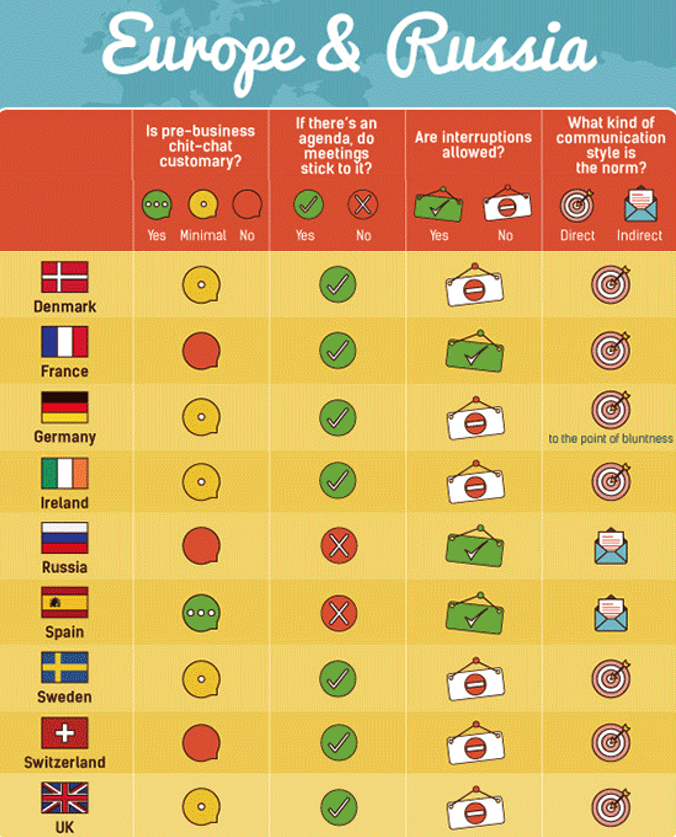
Source: Meetings Net, 2015
Tips:
- Be aware of cultural differences between your country and your target country. Try to adapt your usual business practices to match theirs.
- Address people by their name. In general, it is respectful and may improve goodwill and communication. Never forget to say ‘thank you’ when dealing with European buyers.
- Try to learn and use a few words in your buyer’s native language. They will appreciate the effort.
- Always listen to your potential buyer in meetings. Unless there is an emergency, it is considered bad manners to use a mobile device in a meeting for an unrelated matter.
Tour Operator Guidance: Make your approach relevant
Mar Pages, Co-Founder, Solo Female Travellers

Research potential partners and reach out to them with tailored, considered emails. We get approached a lot, but most potential suppliers do not take any time to get to know us or even understand what we stand for or what would make us choose them, so the pitches are generic and irrelevant.
You should avoid mass emails, and research the target company you are reaching out to so you can send a personalised pitch. Address the company owners/managers by name, read their values and mission as stated on the website, spend time understanding their tone and vocabulary, and pitch a tour idea that has the same elements that the operators offer on all their tours. For example, if a company offers luxury tours, suggest an itinerary that features luxury hotels.
2. Honesty and clarity are vital
Creating positive, sustainable and responsible travel experiences for European tourists is a high priority for European tour operators. Building relationships with suppliers is a crucial part of their business. They work with many suppliers to make this happen, often all over the world. Working with suppliers who are honest, reliable and clear is essential, since it takes time to develop a strong bond with a new supplier. As a local tour operator, building trust from the start will pay off in the long term.
European tour operators are skilled businesspeople who like clear and accurate communication. They like to have immediate answers to queries and problems. If you always reply promptly, this sends a message that you are reliable and professional. Ensure that the information you provide is accurate.
You should also be open to visits and inspections by suppliers. They may want to see proof of your systems and insurance policies.
Tips:
- It is important that you can show you know your destination well and can demonstrate you have strong connections with local service providers. These include suppliers of accommodation, food, transport and tours.
- Be honest about what you can and cannot provide because creating false hope harms trust. Apply this across throughout your working practices. It takes a long time to build trust in a business relationship so honesty is vital.
- Do not exaggerate your capacity, how many visitors you can manage effectively or whether you have enough accommodation capacity for large tour groups. If you manage growth well, you can be open with your buyers about plans for upscaling your business to meet future needs.
- Be upfront about issues that might affect tourism in your country or region, such as security issues. European tour operators constantly monitor safety and security issues on behalf of their clients. They are likely to be aware of any problems in your destination and will expect you to be well informed about them. Again, being honest about everything, including possible risks and any negative developments, builds trust.
- Consult travel advisories from the governments or departments of foreign affairs from your buyers’ countries. For example, in the UK, the Foreign and Commonwealth Office issues travel advice to help British nationals make decisions about travelling abroad. The French Ministry for Europe and Foreign Affairs offers a similar service, Conseils aux Voyageurs.
3. How to have productive meetings with European tour operators
Face to face is often the best way to communicate in business, as personal contact helps to develop relationships faster. 1-2-1 (one to one) meetings can be held in business offices, on location or at trade fairs.
Today, virtual meetings over the internet that use tools like Microsoft Teams, Zoom,Google Meet and Skype are the norm for face-to-face meetings. It is much cheaper to meet online, particularly if you are meeting for the first time. In time, you can invite potential buyers to visit you in person so you can show them around and give them a taste of what you can offer while getting to know them better.
When scheduling online meetings, it is a good idea to confirm meetings by email. Be sure to begin the meeting on time. Pay attention to time zone differences, office hours and public holidays. In some countries, such as the UK, many offices are open seven days a week.
B2B travel trade fairs are good places to meet European tour operators, such as WTM London and ITB Berlin. The International & French Travel Market (IFTM) in Paris is an important trade fair for countries with French heritage. To find more fairs in Europe, consult the CBI study Tips for finding buyers on the European tourism market, particularly the section Find European buyers at travel fairs.
Figure 2: Face to face meetings are a good way to do business with European buyers

Source: Dylan Gillis @ Unsplash, 2019
Tips:
- Plan a trip to Europe to visit a major trade fair if you can afford it. Have a look at WTM London’s top tips when visiting WTM for the first time to help you make the most of your trip. Consult the exhibitor directories and make a list of potential buyers you would like to talk to. The ITB’s exhibitor list is a good place to start.
- Schedule meetings with tour operators and set them up well in advance. Ensure you follow up promptly after every meeting, even if it is just to say ‘thank you for your time’. If they do not have time to meet you at the fair, suggest meeting at their offices. You could arrange to meet multiple operators on one trip to make the most of your time.
- Make sure that the technology you have in your office is as up to date as possible so you can stay in regular contact with buyers. Find an IT expert to help you with your systems if you need to.
- Make sure you return calls and respond to email queries within a maximum of 24 hours. Even just saying ‘we will get back to you when we have an answer’ is good. Make sure you stick to what you commit to and keep in regular touch.
- Ensure that your phone is answered by someone who can speak English reasonably well and is a confident communicator.
4. Create a unique selling point for your product
Travelling to developing countries is often regarded as adventurous. However, the market is crowded and competitive, and European tour operators are always on the look-out for ways to differentiate their itineraries from others. Creating a unique selling point (USP) for your adventure product will help it stand out from other similar trips and experiences on the market. Read the CBI report How to determine your unique value proposition for more information.
To help identify your USP, you should conduct an analysis to identify your strengths, weaknesses, opportunities and threats, known as a SWOT analysis.
Figure 3: SWOT Analysis Diagram
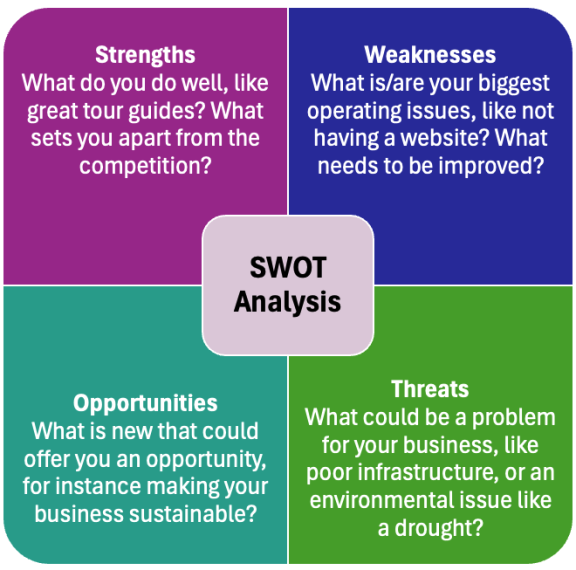
Source: Acorn Tourism Consulting, 2024
SWOT analyses are often carried out in brainstorming sessions. Invite your staff to take part in the brainstorming session and encourage honesty and ideas. Use a flipchart and the guide above to help. Write everything down: nothing is wrong or a bad idea.
- ‘Strengths’ and ‘weaknesses’ refer to factors within your business.
- ‘Opportunities’ and ‘threats’ refer to external factors, such as being a sustainable business (opportunities) or environmental and political factors (threats).
Imagine that you are the customer. Consider what they need. Make sure you have a clear understanding of what is special about your destination and the product you offer. You should also analyse your competitors’ USPs so you can differentiate yourself. Take a look at these examples of best practices from tour operators with clear USPs.
- Absolute Zambia Safaris, Zambia: Tailor-made safaris that are responsible and receive five-star reviews.
- Authentic Adventures, Vietnam: Private tours that are authentic and adventurous, ‘spicing up the southeast Asian adventure travel scene’.
- Eco Tours, Costa Rica: Eco tours provided by local guides – ‘connect with nature’.
- Bamboo Ecotours, Uganda: Small group sustainably-managed tours to see gorillas, wildlife and authentic culture.
Figure 4: The USP of Bamboo Ecotours, Uganda

Source: Bamboo Ecotours, 2024
Here are some other ideas for creating a USP to make your product stand out:
- Ensure your USP is very visible on your homepage, like the example above. Research other tour operators, both local and European, to get ideas about how you can create and display your own.
- Make sure your guides are trained, have qualifications and are knowledgeable. They should have good reviews and recommendations.
- Cater to different languages to broaden your market.
- Visit different places from those offered by competing suppliers.
- Offer a combination of experiences to add value.
- Include community engagement to enhance traveller experience.
Read this article, How to supercharge your travel brand with a killer value proposition, to see how big travel brands target their customers using USPs.
Tips:
- Stay up to date on emerging trends that could provide opportunities for you to develop your USP. Read the CBI report on Trends, opportunities and risks in the European outbound tourism market. This report is updated every year.
- Ensure your trips and experiences are created under sustainable and responsible principles. Promote this to your customers as sustainability is important to European travellers.
- Clearly state what is special, different or unique about your products, and make sure you tell your buyer.
- Once you have created your USP, make it part of your strapline (also known as a tagline), and feature it prominently on your website and promotional material.
5. Consider teaming up with DMCs or other local tour operators
Many European tour operators do business with destination management companies (DMCs). DMCs are professional service companies that provide local tourism products to European tour operators. They also work with local operators to help them diversify business practices and make them more efficient. DMCs usually work with local operators that specialise in specific niches, such as bird watching tours, cultural tours, adventure excursions and hiking trips.
European tour operators like working with DMCs because they are local experts. They can also pick and choose which tours to add to their itineraries. Examples of DMCs include:
Figure 5: Market niches provided by Blue Lanka Tours, Sri Lanka

Source: Blue Lanka Tours, 2024
You can also consider joining other local operators to create a coordinated marketing effort to promote to European tour operators. If you all present yourselves as a collective organisation with similar or complementary products, this may be more attractive to European tour operators.
Working with a DMC or collectively with other local operators can also enhance your reputation. It could also help save on shared marketing costs when attending trade fairs.
Tips:
- Contact DMCs that operate in your region to find out how to become a trusted local operator.
- Check the trips and experiences of other local tour operators in your area offer to find out how they are similar or complementary to yours. Contact other local operators in your region to find any common ground for potential joint business opportunities.
- Read the CBI’s Tips for finding buyers in the European tourism sector to identify trade shows and tourism fairs where DMCs also often exhibit.
6. Market your trips and experiences online
Your website is the face of your business for European tour operators and independent travellers. The internet is a key tool that most European tourists use to research their holidays. Your website should be professionally designed and offer inspirational content that appeals to potential buyers.
European tour operators are likely to do business with you under their name. This means they will purchase your services and market the trip to customers under their brand. They will create their own marketing materials, but they will rely on you to send them detailed information to ensure the details they publish are accurate.
It is crucial that you are responsive and thorough when you provide information. Your buyers work to tight deadlines and cannot afford to miss them. If any changes occur, such as a change in itinerary or price, you should inform them immediately. Not informing your buyers will harm your relationship.
Build a website
If you do not have a website, consider building one. There are many online website builders that offer good value packages and are easy to use. Examples include GoDaddy, Wix and Weebly. Weebly even offers a basic website for free in return for featuring their brand name on your website.
European travellers (consumers) spend a lot of time researching where to go and which trips to take before booking. An inspiring, well-designed website with full trip details, lots of images and videos will appeal to buyers, and they may buy from you directly.
However, you should ensure your website is suitable for either B2B (business to business) or B2C (business to consumer), or aimed at both, with specific sections for both markets.
Read the CBI study How to be a successful tourism company online for more information on creating a website and enhancing your online presence.
Set up a Google Business Profile (GBP)
Once you have a website, people need to be able to find it. Creating A Google Business Profile (GBP) is a good place to start. A well-managed GBP can be part of a key marketing strategy. GBPs are particularly useful for local businesses and SMEs in local markets that do not have large enough advertising budgets to generate significant paid or organic traffic. The aim of GBPs is to connect local users with local businesses. In the case of travel, this could mean tourists looking for local businesses before they travel or if they are already in the destination.
GBPs are displayed in three formats:
- A Knowledge Panel: This shows up when a particular business has been searched for by name or has been clicked on via the Local 3 Pack. Knowledge Panels show up on the right-hand side of the first page of the search results (see Figure 7 below for examples).
- Map.
- Local 3 Pack: After ranking highly in organic search results, a position in the Local 3 Pack is the next most important thing and should be the focus of your efforts.
The way the Local 3 Pack works in tourism is that when a user searches for a local tour or activity, the business profiles of three local operators are displayed on the first page after any paid or sponsored links (shown below). These are not website links; they are business profiles.
All the tour operators in the figure below are featured on the first search page for free. This would not have happened if they had not optimised their Google Business Profiles. You do not have to have a website to have a Google Business Profile, but it will help your business if you do. Figure 6: Google Business Profiles – Map and Local 3 Packs
Tips:
- Contact DMCs operating in your country or region to find out how to become one of their local operators.
- Check the trips and experiences other local tour operators in your area offer to find out how they are similar or complementary to yours.
- Contact other local operators in your country or region to find any common ground for potential joint business opportunities.
- Read the CBI’s Tips for finding buyers in the European tourism sector to identify trade shows and tourism fairs where DMCs also often exhibit.
7. Market your trips and experiences online
Your website is the face of your business for European tour operators and independent travellers. The internet is a key tool that most European tourists use to research their holidays. Your website should be professionally designed and offer inspirational content that appeals to potential buyers.
European tour operators are likely to do business with you under their name. This means they will purchase your services and market the trip to customers under their brand. They will create their own marketing materials, but they will rely on you to send them detailed information to ensure the details they publish are accurate.
It is crucial that you are responsive and thorough when you provide information. Your buyers work to tight deadlines and cannot afford to miss them. If any changes occur, such as a change in itinerary or price, you should inform them immediately. Not informing your buyers will harm your relationship.
Build a website
If you do not have a website, consider building one. There are many online website builders that offer good value packages and are easy to use. Examples include GoDaddy, Wix and Weebly. Weebly even offers a basic website for free in return for featuring their brand name on your website.
European travellers (consumers) spend a lot of time researching where to go and which trips to take before booking. An inspiring, well-designed website with full trip details, lots of images and videos will appeal to buyers, and they may buy from you directly.
However, you should ensure your website is suitable for either B2B (business to business) or B2C (business to consumer), or aimed at both, with specific sections for both markets.
Read the CBI study How to be a successful tourism company online for more information on creating a website and enhancing your online presence.
Set up a Google Business Profile (GBP)
Once you have a website, people need to be able to find it. Creating A Google Business Profile (GBP) is a good place to start. A well-managed GBP can be part of a key marketing strategy. GBPs are particularly useful for local businesses and SMEs in local markets that do not have large enough advertising budgets to generate significant paid or organic traffic. The aim of GBPs is to connect local users with local businesses. In the case of travel, this could mean tourists looking for local businesses before they travel or if they are already in the destination.
GBPs are displayed in three formats:
- A Knowledge Panel: This shows up when a particular business has been searched for by name or has been clicked on via the Local 3 Pack. Knowledge Panels show up on the right-hand side of the first page of the search results (see Figure 7 below for examples).
- Map.
- Local 3 Pack: After ranking highly in organic search results, a position in the Local 3 Pack is the next most important thing and should be the focus of your efforts.
The way the Local 3 Pack works in tourism is that when a user searches for a local tour or activity, the business profiles of three local operators are displayed on the first page after any paid or sponsored links (shown below). These are not website links; they are business profiles.
All the tour operators in the figure below are featured on the first search page for free. This would not have happened if they had not optimised their Google Business Profiles. You do not have to have a website to have a Google Business Profile, but it will help your business if you do.
Figure 6: Google Business Profiles – Map and Local 3 Packs
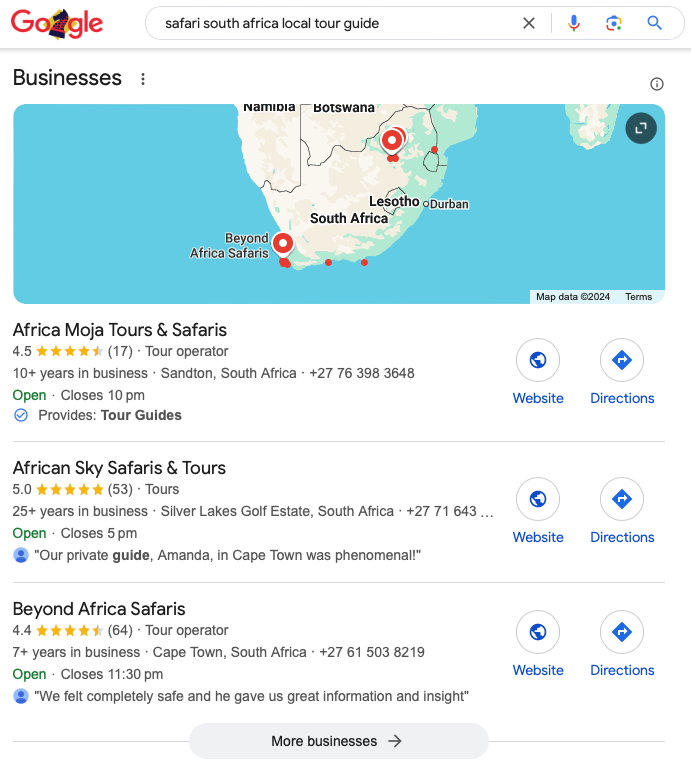
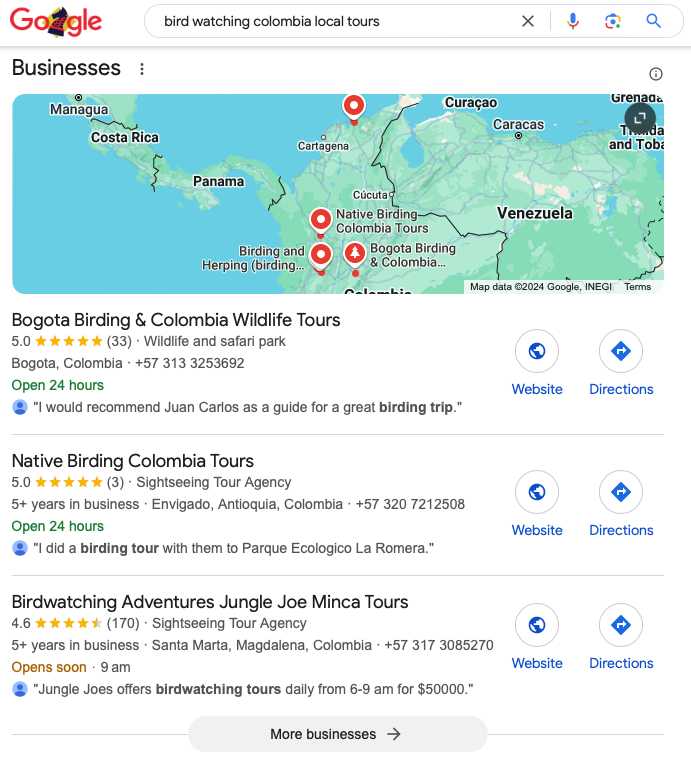
Source: Google, 2024
You start by creating your business profile. This is free, and you can find out how on Google Business Profile. Look at the examples of two local operators below. Note how the operators have included all the important details, as well as photos and maps, links to their websites, customer reviews and contact details.
Figure 7: Examples of Local Operators’ Google Business Profiles – Knowledge Panels
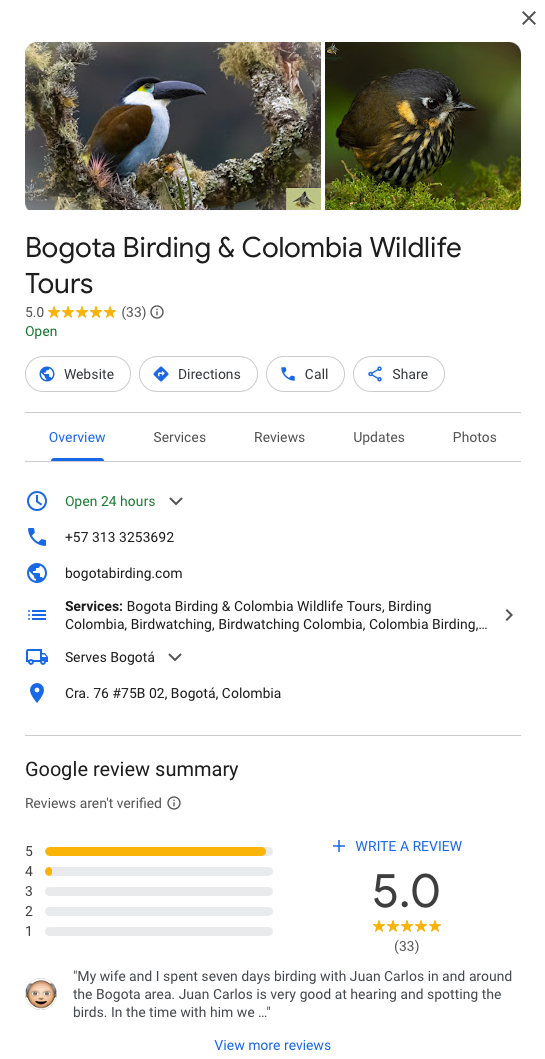
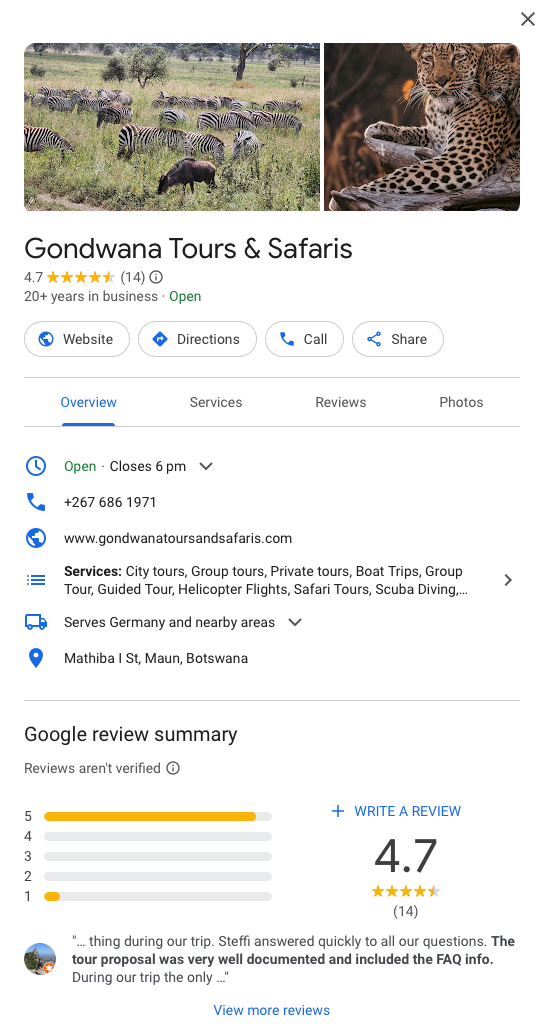
Source: Google, 2024
For more information on how GBP works, read this blog: Mastering Google Business Profile for Tourism Operators. You can find many other guides online.
Tips:
- Make an honest appraisal of your website. Does it tell potential buyers everything they need to know? Is it inspirational? Which parts need updating? Could it do with a refresh? Ask your website designer for help (if you have one) to find out what options there are for you to make changes.
- List all the important information for your business that needs to be on your GBP. Look at other profiles in your destination to make sure you have listed everything.
8. Set a fair price for your services
If you sell to both European tour operators and directly to consumers, you will need to create two different pricing structures. Both will expect transparency in pricing. Start with a basic fee and add extras so your buyer can pick and choose what suits them best. Avoid having a fixed price structure. This is inflexible and might not meet your specific buyers’ needs.
A transparent pricing structure will help buyers to understand the possible combinations and the overall structure of your trip or product. This will lead to satisfied customers and better reviews.
Start by setting a fair price for a basic itinerary, such as a set route that includes basic accommodation for one night. You can then add optional extras, such as additional nights, excursions to local markets and optional activities. You might want to consider additional upgrade fees for professional guiding or interpretation services.
When employed under clear, honest terms, differential pricing and upselling can provide greater transparency and trust than fixed, all-in pricing. For more information, you can read this helpful blog, which outlines five tips for pricing your tourism products. You should look at this article: 12 tourism pricing problems and how to avoid them to help you get it right.
When dealing with new buyers, make sure you enter into a formal contract. You may want to request a prepayment for the first services or the first six months. You could then renegotiate as the partnership develops and becomes more solid.
Tips:
- Check your pricing against your competitors. If your tours are more expensive, make sure you offer more value for the higher price.
- Be precise and clear about your pricing and options, especially what prices do and do not include.
- Discuss and agree payment terms with tour operators, especially when payments are made. In Europe, it is not uncommon for terms of payment to be within 30 days. Take a look at this guide: 5 common payment methods for international trade.
- Ensure your payment methods are easy for independent travellers. Credit card payments for online bookings are convenient and common throughout Europe. For direct bookings, credit card payments can give you and your customer convenience and peace of mind. Consult the CBI’s study How to implement online payment for more information.
- Consider making credit card fees part of the prices you charge. European travellers do not like additional fees being added to quoted prices.
9. Be upfront about infrastructure and service provision in your destination
Inadequate infrastructure and service provision can affect the tourism industry in developing countries. For example, luxury hotels and pristine beaches that are difficult to reach may not be attractive to European buyers. Infrastructure and services refer to transportation by air, land or water, communication by phone or internet, electricity, water supply and other basics that European travellers may expect.
Being knowledgeable about infrastructure and service limitations at your destination is important in developing an open and honest relationship with buyers. It is important for European tour operators to be confident that their customers get the services they expect and pay for.
Tips:
- Honestly assess the infrastructure in your destination so you can address it frankly with potential buyers. Being open and honest about issues will impress them. Make sure you can advise buyers about any workable solutions to problems they raise.
- Research and stay informed about any major infrastructure investments planned in the short, medium and long term.
- As your business grows, keep assessing conditions and changes in infrastructure to measure how they will affect growth.
- Ask other local operators and trade associations to press relevant governmental bodies or other professional bodies for improvements to infrastructure.
- Ensure you make travellers aware of potential health risks, such as of areas where malaria is prevalent, so you can advise your buyers accordingly.
10. Join trade membership organisations
Being a member of a tourism trade organisation can help you gain credibility. While not mandatory, joining a trade membership organisation will help build your reputation as a trustworthy local operator, and it will create good networking opportunities. European tour operators rely on local, dependable operator partners to keep travellers safe. Being a member of a trustworthy trade body helps to prove that your business is one such operator.
Tips:
- Identify suitable tourism trade associations active in your region and their membership criteria. The Latin American Travel Association (LATA), for example, promotes Latin America as a tourist destination. Similar organisations include the Pacific Asia Travel Association (PATA) and the Africa Tourism Association (ATA).
- As a non-EU operator selling to buyers in the European Union, you may be able to register with European tourism trade associations, such as the European Tour Operators Association (ETOA).
- Look for which international membership organisations fit your business best. The Adventure Travel Trade Association (ATTA), for example, is a global membership organisation for a wide variety of travel companies, including tour operators.
- Ensure you feature membership logos prominently on your website and other promotional materials.
Do not forget to connect with your local tourist
Seek advice
Export promotion schemes operated by government agencies and non-governmental organisations (NGOs) in developed countries play an important role in helping SMEs in developing countries improve their export performance. They often provide advice and training.
- The Swiss Import Promotion Programme (SIPPO) supports local tour operators in Colombia, Peru, Albania and North Macedonia to find European buyers for sustainable tourism activities through business support organisations.
- Germany’s Import Promotion Desk (IPD) supports local tour operators to develop sustainable tourism activities in Ecuador, Tunisia, Nepal Sri Lanka and Uzbekistan. The IPD offers training and workshops to help suppliers prepare for the requirements of the European travel market and to connect with potential buyers. The IPD can also put you in touch with European tour operators at the ITB and WTM world trade fairs.
- The International Trade Centre (ITC), the joint agency of the World Trade Organization and the United Nations, helps SMEs become more international through improving competitiveness and connecting with relevant markets. Its tourism section helps emerging markets provide sustainable tourism products and services. The ITC works with countries including Myanmar, Laos, The Gambia, Eswatini, Uganda and the Caribbean.
- The European Commission’s Enterprise Europe Network provides support and expertise for SMEs doing business with international partners. It maintains a list of partnership opportunities. Use the filter and select ‘travel’.
- The European Commission’s Access2Markets is the EU gateway to trade information. It provides comprehensive information about trading with EU countries.
- Many European nations have chambers of commerce that support exports and imports. In the UK, Chamber International provides British businesses with information on importing goods and services. The Association of German Chambers of Commerce and Industry plays this role in Germany.
- Contact the trade desks of embassies and consulates from your target countries to see if they can supply export and import guides.
The CBI has produced other publications that might be of interest to you:
- Before doing business with European buyers, you should research the market thoroughly. The CBI’s report on Tips for finding buyers in the European tourism sector provides some practical advice.
- To ensure a successful launch of your travel product in the European market, read the CBI’s tips for organising your tourism export to Europe.
- Additionally, the CBI’s Exporting to Europe Guide may also yield useful information.
Acorn Tourism Consulting Limited carried out this study on behalf of CBI.
Please review our market information disclaimer.
Search
Enter search terms to find market research

